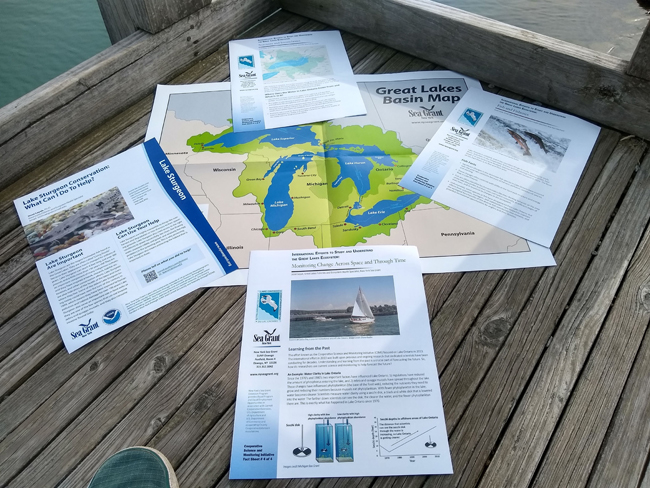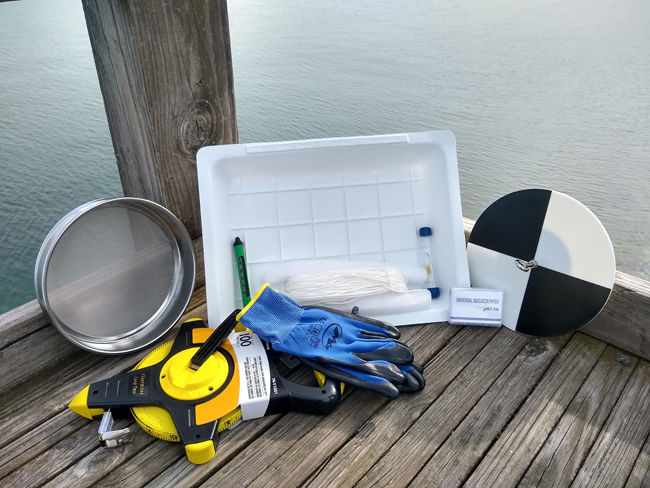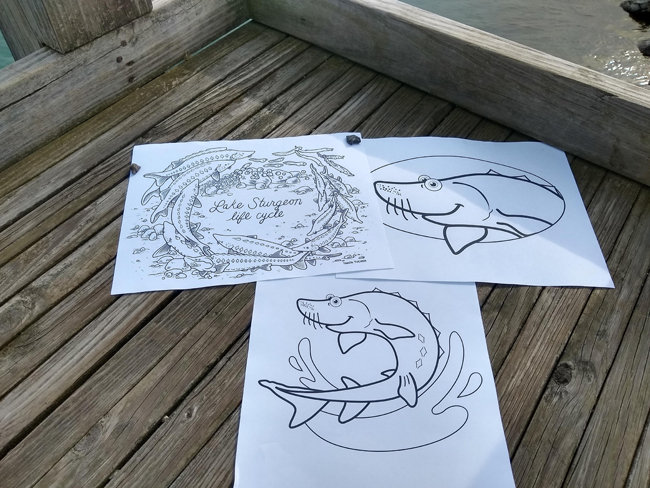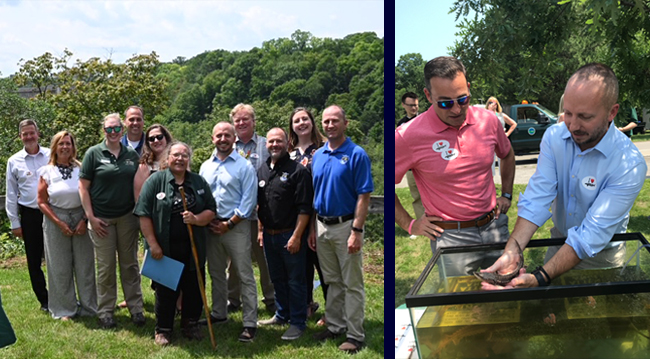Recent Discoveries in Genesee River, Oneida Lake Creating New Excitement about Restoration of “Living Fossil Fish”
Contacts:
Nate Drag, New York Sea Grant Great Lakes Literacy Specialist, E: nwd4@cornell.edu, P: (716) 645-3610
Stacy Furgal, New York Sea Grant Great Lakes Fisheries and Ecosystem Health Specialist, E: slf85@cornell.edu, P: (315) 312-3042
Kara Lynn Dunn, NYSG's Freelance Great Lakes Publicist, E: karalynn@gisco.net, P: (315) 465-7578
Buffalo, NY, July 15, 2021 — New York Sea Grant has published a suite of lake sturgeon education resources to support student and public awareness about one of the Great Lakes’ largest and longest-living native fishes.
With a grant from the Disney Conservation Fund, New York Sea Grant has developed a Lake Sturgeon Intermediate Curriculum with activities that meet Next Generation Science and Learning Standards for grades 4-6. Collateral materials include digital worksheets, field sampling equipment, a fish tracking tag, and the Tale of a Great White Fish book about a fish facing survival challenges similar to those threatening the lake sturgeon.
The Lake Sturgeon Intermediate Curriculum, teaching resources, and six-part video series on lake sturgeon produced in partnership with Cornell University are freely accessible online at www.nyseagrant.org/lakesturgeon.
New York Sea Grant’s Great Lakes Fisheries and Ecosystem Health Specialist Stacy Furgal said, “New York Sea Grant’s new suite of lake sturgeon-related conservation and education resources are designed to serve as a springboard into the world of science, environmental stewardship, and STEM-based careers by featuring this charismatic and threatened species that is so important to the Great Lakes region.”
“To broaden the reach of the curriculum to all grade levels, input from teachers participating in two curriculum development workshops is incorporated in each of the 10 lessons,” said Nate Drag, Great Lakes Coastal Literacy Specialist with New York Sea Grant and Associate Director of the Great Lakes Program at the University at Buffalo.
Teachers interested in obtaining a Lake Sturgeon Intermediate Curriculum with supplemental materials to encourage skill development in reading and comprehension, mathematics, ecology, graphing, history, and the arts may contact Nate Drag at 716-645-3610, nwd4@cornell.edu.
New Excitement for Lake Sturgeon Restoration Success
Recent identification of lake sturgeon of significant size in New York waters by federal, state, and academic researchers are creating new excitement around the success of a stocking effort designed to restore lake sturgeon to New York’s waters.
On May 25, 2021 U.S. Geological Survey Research Ecologist Dawn Dittman, Ph.D., captured a female lake sturgeon 18 years after it was stocked as a juvenile fish into the Genesee River. Three days later Cornell University fisheries researchers captured a 159-pound, 73.6-inch lake sturgeon, the largest fish ever recorded from Oneida Lake. After the researchers collected data to support their restoration efforts, the fish were released.
Furgal noted, “These recent discoveries of lake sturgeon in New York waters are significant milestones in the effort to restore this unique fish and add to our excitement to share New York Sea Grant’s new teaching resources on lake sturgeon.”
Once abundant in New York State, the lake sturgeon species has been a State-designed “Threatened” species since 1983. Conservation and stocking programs in New York State are restoring the populations of the fish called a “living fossil” for its prehistoric appearance. The fishing of lake sturgeon is still prohibited in New York State.
New York Sea Grant is partnering with personnel from Cornell University, the New York State Department of Environmental Conservation (NYSDEC), New York Sturgeon for Tomorrow, Saint Regis Mohawk Tribe Environment Division, Seneca Park Zoo, U.S. Fish and Wildlife Service, U.S. Geological Survey, and others in the lake sturgeon restoration effort.
For more information on the New York State Lake Sturgeon Recovery Plan, please see the NYS Department of Environmental Conservation Website.

Components of the New York Sea Grant Lake Sturgeon teaching resources suite for student and public education. Credit: Nate Drag/New York Sea Grant.

Lake Sturgeon Intermediate Curriculum field sampling gear. Credit: Nate Drag/New York Sea Grant.

New York Sea Grant Lake Sturgeon Intermediate Curriculum coloring pages. Credit: Nate Drag/New York Sea Grant.

NYSDEC Commissioner Basil Seggos (above, at far right in second picture, holding a lake sturgeon) announced on Thursday, June 16, 2021 a historic milestone in the recovery of Lake Sturgeon in New York. In May 2021, crew from the U.S. Geological Survey netted a nearly 70 pound spawning female lake sturgeon in the Genesee River — the first in more than 50 years.
The DEC works closely with regulatory partners at the USGS, U.S. Fish and Wildlife Service, and U.S. Environmental Protection Agency, as well as Monroe County Department of Health, to improve water quality and restore habitat in the Rochester Embayment Area of Concern. The return of spawning lake sturgeon provides further evidence that restoration efforts are leading to tangible improvements to the ecosystem and support fisheries restoration and management goals.
In addition, the Seneca Park Zoo and New York Sea Grant (NYSG's Furgal is pictured above, second from right in the first picture) help educate the public about lake sturgeon and the Genesee River.
More Info: New York Sea Grant
New York Sea Grant (NYSG), a cooperative program of Cornell University
and the State University of New York (SUNY), is one of 34 university-based
programs under the National Oceanic and Atmospheric Administration’s
National Sea Grant College Program.
Since 1971, NYSG has represented a statewide network of integrated
research, education and extension services promoting coastal community
economic vitality, environmental sustainability and citizen awareness
and understanding about the State’s marine and Great Lakes resources.
Through NYSG’s efforts, the combined talents of university scientists
and extension specialists help develop and transfer science-based
information to many coastal user groups—businesses and industries,
federal, state and local government decision-makers and agency managers,
educators, the media and the interested public.
The program maintains Great Lakes offices at Cornell University, SUNY
Buffalo, SUNY Oswego and the Wayne County Cooperative Extension office
in Newark. In the State's marine waters, NYSG has offices at Stony Brook
University in Long Island, Brooklyn College and Cornell Cooperative
Extension in NYC and Kingston in the Hudson Valley.
For updates on Sea Grant activities: www.nyseagrant.org has RSS, Facebook, Twitter, Instagram, and YouTube links. NYSG offers a free e-list sign up via www.nyseagrant.org/nycoastlines for its flagship publication, NY Coastlines/Currents, which is published quarterly.